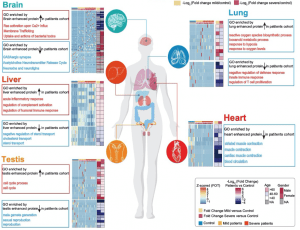Disclaimer: This is a summary of an article that is in a preprint and has not been peer reviewed.

Systematic summary of the GO pathways enriched by tissue-enhancedproteins that exhibited altered expression among control, mild, and severe patient groups. The heatmap of each panel indicates expression patterns of tissues-enhancedproteins among control, mild, and severe patient groups. The fold changes in tissue-enhancedproteins between mild/severe patient samples and control samples are shown on the right of heatmap. (Source; Chen et al., Pre-Print)
Dysregulated immune responses along with metabolic dysfunction can lead to multiple organ failure, which seems to be a hallmark of COVID-19 severity. In a recent pre-peer reviewed paper, authors used a transcriptomic, proteomic and metabolomic approach in peripheral blood to distinguish the range COVID-19 severity in 66 individuals with confirmed symptoms. There was “continuous activation of IFN-I signalling and neutrophils and a high level of inflammatory cytokines” in severe disease. COVID-19 in mild patients was “characterised by robust T cell responses”. Poor outcomes with severe COVID-19 were associated with increased levels of D-dimer and fibrinogen degradation products and a decrease in F13A1 expression, indicating that blood clotting status may be one key factor to monitor in COVID-19 progression.
Article: Chen et al., Pre-print. COVID-19 severity is associated with immunopathology and multi-organ damage. MedRxiv
Summary by Clive Gray










